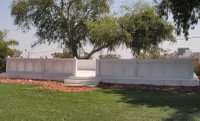Last week, a rocket hit a shopping mall in city; the dozens of injured treated at the Barzilai Medical Center.
It turns out the hospital grounds contain a remarkably interesting bit of history: a site holy to certain Shiite Muslims, thousands of whom have come to pray there over the years. Ashkelon itself has 5,000 years of recorded history, but when the hospital was first built in 1961, nothing indicated that the hill out back was anything special.
The consecration of the site dates back to the early days of Islam. The decades that followed the death of the prophet Muhammad in 632 were marked by a bitter and bloody dispute over succession, a conflict that ultimately marked the split between Sunni and Shiite Muslims.
In a nutshell, Ali, Muhammad's cousin and son-in-law, was repeatedly passed over for the position of caliph -- leader of the young Muslim nation. Ali's followers (the word Shiite means "partisans") eventually rebelled, touching off years of conflict.
After Ali was assassinated in 661, his sons Hasan and Hussein carried on his struggle. Hussein and his small rebel army were slaughtered in 680 in what is now the Iraqi holy city of Karbala. His head was delivered as a trophy to Yazid, the victorious caliph, in Damascus, while his body remained in Karbala. Shiites commemorate Hussein's death annually in the intense day of mourning known as Ashura.
Both Karbala and Damascus became sites of Shiite pilgrimages. Sunni rulers, displeased with the phenomenon, decided to relocate Hussein's head to the far edge of the kingdom -- Ashkelon. It remained there for several centuries, when when legendary Muslim leader Saladin sent the head to Egypt for safekeeping from the invading Crusaders.
What was once the far end of an ancient Muslim kingdom is now a grassy mound behind the delivery rooms of an Israeli hospital.
A millennium after Hussein's head was removed from Ashkelon, the site is still revered by an offshoot of Shiites mostly from India and Pakistan. The pilgrims who have come to visit include some from countries with no diplomatic relations with Israel, hospital officials say.
About a decade ago, a Shiite spiritual leader arrived at the hospital with an unusual request: to be allowed to erect a prayer area for the pilgrims.
"How do you know this is the site?" asked Dr. Ron Lobel, deputy director of the medical center.
"I walked out to the mound with him," Lobel said. "He took out a shovel and started digging. To my astonishment, a meter or so deep, he exposed the cornerstone of the ancient mosque that had been built where the head had been buried, and was later destroyed by the Crusaders."
With the hospital’s blessing, the worshipers imported the most valued marble in India, the kind used to build the Taj Mahal. The prayer area, built seven or eight years ago, is open to the pilgrims. They arrive in buses, coordinate with the center's security, park in the lot and walk to the mound to pray.
"They are quiet, peaceful people. They come in silence, sometimes barely uttering a sound," said Lobel, who has become the resident expert on the subject over the years. "An island of Shiite Muslim prayer in an Israeli hospital in a Jewish state," said Lobel of his unusual charge, satisfaction in his voice. "It really is unique."
—Batsheva Sobelman in Jerusalem.
Photo: The marble prayer area on the hospital grounds. Credit: David Avioz/Barzilai Medical Center
-----
Notes: Asqalaan has been a sacred ground for the fatimids since a very long time. During the era of Imam Mustansir (AS), the Commander in Cheif of the Fatemi Empire Molana Badrul Jamali has built a masjid in the area that has been mentioned in the above article. The entire incident of Rasul Husain (AS) being revealed during this era in the presence of the mentioned commander has been inscribed on a pulpit that is now present in the masjid of Baytul laham (Bethlelem) where the shrine of Nabiullah Ibrahim is. The inscription is in Fatemi Kufic and it is said that Syedna Taher Saifuddin (RA) was the first to decipher the entire scripture that is written on the said pulpit during his visit to al-Quds. The text of which is present in one of his Rasail Sharifa. Later Syedna Taher Saifuddin (RA) visited the location in Asqalan and pin pointed the exact location where the masjid was built nearby which was the burial shrine of Rasul Imam al-Husain (AS), that was later shifted to Qahera. The entire incident of its being shifted to Qahera was narrated by the person who brought the wooden box containing the Raas Mubarak from the gates of Qahera into the Fatemi Palace, carried on his head. The said boxes are currently placed on display in one of the Museums of Cairo.
